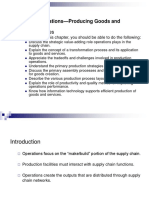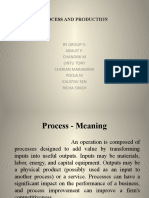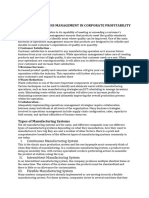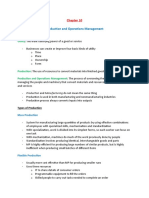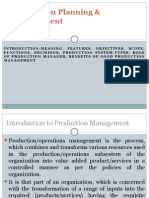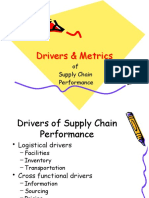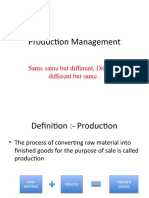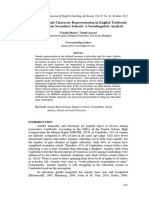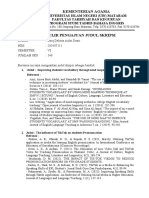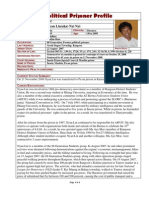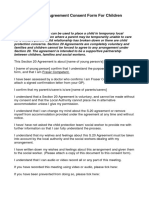Operations Management
Kiran J Mathew
Asst Professor
SCMS Cochin School of Business
�Facilities Location
• Location decisions pertain to the choice of appropriate geographical
sites for locating various manufacturing and/or service facilities of an
organization.
���Location Planning Methods
• Generally, location decisions could be one of
the two: one facility–multiple candidates and
multiple facilities–multiple candidates.
• 1. Location Factor Rating
�• 2. The Centre-of-gravity Method
�• 3. The Load–Distance Method
�Transportation Problem
• The transportation problem is a
type of Linear Programming
Problem in which commodities
are carried from a set of sources
to a set of destinations while
taking into account the supply
and demand of the sources and
destinations, respectively, in
order to reduce the total cost of
transportation.
�Process Design Process Strategy
• A process is the basic building block of • A process (or transformation) strategy is an
operations. organization’s approach to transforming
• It consists of a set of activities that need to be resources into goods and services.
performed by consuming some resources and • The objective of a process strategy is to build
time. a production process that meets customer
requirements and product specification
• This eventually determines the performance within cost and other managerial constraints.
of the operations systems in terms of cost,
time, productivity, profit, etc.
• Every activity that constitutes a process must
be identified.
• It is also important to know the time taken for
each activity and the nature of flow of
materials/information in the process.
• A pictorial representation of all this
information could be developed using process
flow-charting
��• Process focus strategy • Product focus strategy
• Has high product flexibility • Organizes the facility into products
• Causes variable product flow, indicating planning • Uses a long and continuous production line that
and scheduling challenges helps in efficient processes
• Requires general-purpose equipment and skilled • Requires less skilled employees
personnel • Requires high fixed cost but low variable cost
• Requires lower initial capital investment
• Mass customisation strategy
• Repetitive focus strategy • Uses flexible manufacturing processes and
• Managers organize facilities as assembly lines computer-aided information to create
• Increased efficiency compared to the process- customized products
based strategy but is less flexible • Combines the flexibility of a process or
• Modules can combine into many output options transformation strategy with the efficiency of a
product-focus strategy
• Provides businesses with a competitive
advantage and increases their economic value
• Increases customer satisfaction and experience
• Ensures raw material inventory is low
����Capacity Planning (Capacity Requirement
Planning, CRP)
• Capacity often refers to an upper limit on the rate of output.
• Capacity = Work + Waste
• Capacity utilization = Capacity put to use / Total capacity available
• Capacity planning refers to the strategic process of determining and
allocating resources in order to meet the current and future demands of an
organization effectively.
• Capacity planning in operations management involves analyzing the
capacity of various resources, such as production facilities, equipment,
labor, and technology, to ensure they can meet the demands of the
production process. It aims to strike a balance between capacity and
demand to avoid overutilization or underutilization of resources.
�• Strategic Capacity Planning • When is Capacity Planning
• Lag Strategy Required?
• Lead Strategy • New Business Ventures
• Match Strategy • Business Expansion
• Seasonal Demand
• Operational Changes
�• Alternatives to Capacity
Augmentation
• Waste Elimination
• Multi-skilling of the Workforce
• Subcontracting/Outsourcing
��Aggregate Planning
• The goal of aggregate planning is to
achieve a production plan that will
effectively utilize the organization’s
resources to match expected demand.
• Aggregate planning decisions are
strategic decisions that define the
framework within which operating
decisions will be made.
• They are the starting point for scheduling
and production control systems.
• They provide input for financial plans;
• They involve forecasting input and
demand management
• They may require changes in
employment levels.
�• Basic Strategies:
• Level Capacity Strategy:
• Maintaining a steady rate of
output while meeting variations in
demand by using a combination of
inventories, overtime,
subcontracting and back orders.
• Chase Demand Strategy:
• Matching capacity to demand i.e,
operations would be planned to
meet expected demand for that
period.
�• Level Capacity Strategy:
• Maintain steady output
• Maintain a steady work force as hiring and layoffs can have a major impact on
the morale of employees
• Inventory can take up large storage area and costs.
• Chase Demand Strategy:
• Vary output to demand needs
• Inventories can be kept relatively low
• Lack of stability in operations
• Also when actual demand doesn’t meet forecast, morale of employees can
suffer.
�Master Scheduling
• Disaggregating the Aggregate Plan
• Breaking down the aggregate plan
into specific product requirements
in order to determine labor
requirement, materials and
inventory requirements.
• Translating the production plan
into meaningful terms for
production.
• The result of the disaggregating the
aggregate planning is the Master
schedule.
�• MASTER SCHEDULING • Functions of Master Scheduling:
• The result of disaggregating an • Interfaces with
aggregate plan.
• It shows the quantity and timing of – Marketing
specific end items for a scheduled – Capacity planning
time (6 to 8 weeks ahead). – Production planning
• It shows planned output for individual – Distribution planning
products along with time of
production. • Evaluates impact of new orders
• Shows when completed orders are to • Provides delivery dates for orders
be shipped.
• Deals with problems
– Production delays
– Revising master schedule
– Insufficient capacity
��Types of Manufacturing Processes
�Types of Manufacturing Processes
• Job shop manufacturing • Discrete manufacturing
• Job shop manufacturing uses production areas • Discrete manufacturing uses an assembly or
instead of an assembly line and is most often used production line, though it is much more diverse
for small-batch, custom products that are made-to- than repetitive manufacturing and allows for more
order for certain clients or customers. These frequent changeover and variation. A company can
workstations might focus on one particular product have multiple styles, sizes or modifications for a
or a handful of them product with discrete manufacturing
• Eg: a custom shoemaker or commercial printing • Eg: Automobile and aircraft makers
press
• Batch process manufacturing
• Repetitive manufacturing
• Batch process manufacturing shares similarities
• Repetitive manufacturing is appropriate when with discrete and job shop manufacturing
making repeat production at a committed processes, driven by customer demand or the
production rate. This manufacturing process has availability of ingredients and raw materials. One
dedicated production lines all working on the same manufacturing run might produce a batch enough
product or component all day, every day year- to fill client needs, so you finish production, clean
round. the equipment, and resume when you need
another batch.
• Eg: electronic goods, automobiles or durable
consumer goods like refrigerators • Eg: Food production, newspaper printing
�• Continuous process manufacturing
• Continuous process manufacturing runs all the time like
repetitive manufacturing. The difference is this process
focuses on raw materials that are often gases, powders,
liquids or slurry.
• Eg: Oil refining, metal smelting, paper production and some
food products like tomato sauce, juice
• 3D printing
• Many in the industry now recognize 3D printing as a sixth
manufacturing process with widespread use. Developed in
the 1980s, 3D printing uses various composites and materials
like plastics and metals to make three-dimensional goods
layer by layer based on a digital model, rather than using
physical labor or mechanization. There has been an
enormous expansion in this field, with dozens of equipment
manufacturers and hundreds of thousands of 3D-printed
items already on the market.
• While 3D printing can be expensive, it also offers the
potential to reduce financial capital, raw materials and waste
and lets companies create and test products before
committing to them on a larger scale.
�Group Technology
• Group technology is drawing increasing
interest from manufacturers because of its
many applications for boosting productivity.
• GT is an approach to manufacturing that
seeks to maximize production efficiencies by
grouping similar and recurring problems or
tasks.
• It saves time, avoids duplication, and
facilitates easy and timely information
retrieval and use.
• An important part of GT is the use of a code
that—like a library reference system—serves
as an index to characteristics in
manufacturing, engineering, purchasing,
resource planning, and sales to improve
productivity in each of these areas.
�Flexible Manufacturing System (FMS)
• A flexible manufacturing system (FMS) is a production • Pros and Cons of an FMS
method that is designed to easily adapt to changes in the
type and quantity of the product being manufactured. • The main benefit is the enhancement of production
Machines and computerized systems can be configured to efficiency. Downtime is reduced because the production line
manufacture a variety of parts and handle changing levels of does not have to be shut down to set up for a different
production. product.
• A flexible manufacturing system (FMS) is designed up front to • The disadvantages of an FMS include its higher up-front costs
be readily adapted to changes in the type and quantity of and the greater time required to design the system
goods being produced. specifications for a variety of future needs. Specialized
technicians needed to run, monitor, and maintain the FMS
• Production in an FMS is largely automated, reducing overall also add expense. However, advocates of FMS maintain that
labor costs. the increase in automation typically results in a net reduction
in labor costs.
• An FMS system is, however, more expensive to design and
put in place than a fixed system, and it requires skilled • Who invented the FMS?
technicians.
• Jerome H. Lemelson (1923–1997), an American industrial
engineer and inventor, is credited with developing the
concept of flexible manufacturing. His initial design featured
a robot-based system that could weld, rivet, convey, and
inspect manufactured goods. Systems based on his design
began showing up on factory floors in the United States and
Europe in the late 1960s, becoming even more popular in the
1970s.



